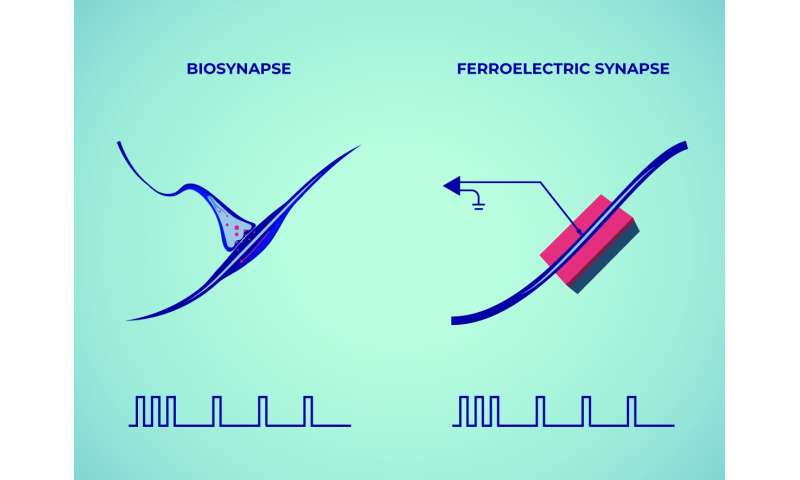Researchers from the Moscow Institute of Physics and Technology have created a device that acts like a synapse in the living brain, storing information and gradually forgetting it when not accessed for a long time. Known as a second-order memristor, the new device is based on hafnium oxide and offers prospects for designing analog neurocomputers imitating the way a biological brain learns. The findings are reported in ACS Applied Materials & Interfaces.
Neurocomputers, which enable artificial intelligence, emulate brain function. Brains store data in the form of synapses, a network of connections between neurons. Most neurocomputers have a conventional digital architecture and use mathematical models to invoke virtual neurons and synapses.
Alternatively, an actual on-chip electronic component could stand for each neuron and synapse in the network. This so-called analog approach has the potential to speed up computations drastically and reduce energy costs.
The core component of a hypothetical analog neurocomputer is the memristor. The word is a portmanteau of "memory" and "resistor," which pretty much sums up what it is: a memory cell acting as a resistor. Loosely speaking, high resistance encodes a zero, and low resistance encodes a one. This is analogous to how a synapse conducts a signal between two neurons (one), while the absence of a synapse results in no signal, a zero.
But there is a catch: In an actual brain, the active synapses tend to strengthen over time, while the opposite is true for inactive ones. This phenomenon, known as synaptic plasticity, is one of the foundations of natural learning and memory. It explains the biology of cramming for an exam and why our seldom-accessed memories fade.
Proposed in 2015, the second-order memristor is an attempt to reproduce natural memory, complete with synaptic plasticity. The first mechanism for implementing this involves forming nanosized conductive bridges across the memristor. While initially decreasing resistance, they naturally decay with time, emulating forgetfulness.
"The problem with this solution is that the device tends to change its behavior over time and breaks down after prolonged operation," said the study's lead author, Anastasia Chouprik from MIPT's Neurocomputing Systems Lab. "The mechanism we used to implement synaptic plasticity is more robust. In fact, after switching the state of the system 100 billion times, it was still operating normally, so my colleagues stopped the endurance test."
The left image shows a synapse from a biological brain, the inspiration behind its artificial analogue (right). The latter is a memristor device implemented as a ferroelectric tunnel junction -- that is, a thin hafnium oxide film (pink) interlaid between a titanium nitride electrode (blue cable) and a silicon substrate (marine blue), which doubles up as the second electrode. Electric pulses switch the memristor between its high and low resistance states by changing hafnium oxide polarization, and therefore its conductivity. Credit: Elena Khavina/MIPT">

The left image shows a synapse from a biological brain, the inspiration behind its artificial analogue (right). The latter is a memristor device implemented as a ferroelectric tunnel junction -- that is, a thin hafnium oxide film (pink) interlaid between a titanium nitride electrode (blue cable) and a silicon substrate (marine blue), which doubles up as the second electrode. Electric pulses switch the memristor between its high and low resistance states by changing hafnium oxide polarization, and therefore its conductivity. Credit: Elena Khavina/MIPT"/>
Fig. 1
The left image shows a synapse from a biological brain, the inspiration behind its artificial analogue (right). The latter is a memristor device implemented as a ferroelectric tunnel junction -- that is, a thin hafnium oxide film (pink) interlaid between a titanium nitride electrode (blue cable) and a silicon substrate (marine blue), which doubles up as the second electrode. Electric pulses switch the memristor between its high and low resistance states by changing hafnium oxide polarization, and therefore its conductivity. Credit: Elena Khavina/MIPT

No comments:
Post a Comment